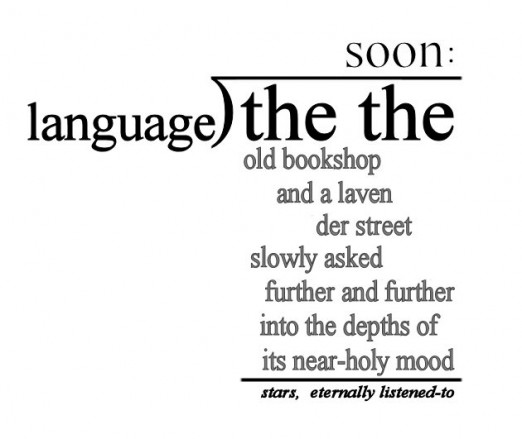The Four Seasons
.
3 31 43 73 5 67 3 61 43 67 67 19 41 13 1 11 19 7 31 5 3 12 15 21 4 19 3 18 15 19 19 9 14 7 1 6 9 5 12 4 8 21 25 33 9 30 8 28 25 30 30 16 24 14 4 12 16 10 21 9 64 441 625 1089 81 900 64 784 625 900 900 256 576 196 16 144 256 100 441 81
.
Today, the solution, with an explanation, to the above.
1. Each line says, “clouds crossing a field.”
2. A reader should know from its looks and the fact that it is a cryptographiku that it is a coded text. He should try simple codes at first on all the lines, the way one would in order to solve a cryptogram. If he’s familiar with my other cryptographiku, he will know I’ve more than once used the simplest of numeric codes. Such is the case here, in line 2. The code is 1 = a, 2 = b, etc.
3. The codes used for the other lines are harder to figure out, but the lines themselves give an important clue as to what they say: they each consist of four words, the first six letters in length, the second eight, the fourth one (which would almost certainly be “a”) and the fourth five. That ought to make one guess that each repeats the decoded one. As each indeed does.
4. It should be evident that the code for the fourth line uses the squares of the numbers in the code for the third. The basis of the arrangement of numbers in the third line will probably not be easy to guess.
5. If you consider what kind of numbers are being used in a given line, and are at all mathematical, you will realize that the numbers used in line one are all primes, with the first prime, 1, representing a, the seond prime, 2, representing be, and so on.
6. The next step is trickier but also requires one to think about kind of numbers. It turns out that the numbers used for the code in line three are the non-primes in order, with first of them, 4, representing a, the second, 6, representing b.
7. The surface meaning of the lines and the kinds of coding they’ve been put in is now known. All that remains is to findif a larger meaning in intended (yes) and, if so, what it is, and what the logic behind the coding is (and the kind of coding used in a cryptographiku is, by definition, meaningful. Wallace Stevens, whom one familiar with my poetry and criticism will know is important to me, helps with the last of these questions. Stevens wrote many poems (“Man on the Dump,” for instance) meditating on the idea that winter is pure reality, summer poeticized reality. Or, winter is primary, so can be metaphorically thought of a consisting of prime numbers only. Spring, by this reasoning, can logically consist of all the (lowest) numbers, summer of oonly factorable numbers, numbers that can be reduced to simpler numbers–expanded, poeticized numbers. Autumn, the peak of the year because it yields the fruit of the year, consists of summer’s numbers squared, or geometrically increased.
8. The final meaning of the poem is derived from its repetition of the simple nature scene about the clouds. A reader aware of Robert Lax’s work (and he will, if he’s familiar with mine), will know that he has a number of poems that repeat words or phrases–to suggest, among much else, ongoingness, permanence, undisturbably serenity. My hope is that this poem will make a reader feel the change of seasons within the grand permanence that Narture ultimately is. A constant message, in different coding as the seasons change.
9. All this should lead to “Whee!”
5. The decoded text uses a technique Robert Lax pioneered in to convey a meaning I consider archetypally deep, like the meanings Lax’s similar poems have for me.
6. The final meaning of the poem is (a) Nature is eternally changing; and (b) Nature is eternally unchanging. When I saw I could make ti say that, I got a thrill! I consider this poem one of my best inventions–even though I’m not sure it works as a poem.
Have fun, kids!
This entry was posted on Friday, December 18th, 2009 at 12:19 PM and is filed under Bob Grumman, infraverbal poetry, Poetics, Robert Lax, Wallace Stevens. You can follow any responses to this entry through the RSS 2.0 feed. You can leave a response, or trackback from your own site.


I really like this one; it strikes me as very E.E. Cummings-inspired, and I love that guy. I think the use of gray is a good idea because it gives the “remainder” more punch at the end. I’m a bit confused on reading your description in which you keep talking about Basho’s pond, which I don’t see in evidence here … I’m thinking if I had seen an earlier version of this, or I was better versed in the Grummanverse, I would understand that. And finally, you won’t have to struggle between “the” or “a” bookshop’s mood soon, where there’s just one bookshop left. Just had to end that with a little (sad) humor!
Oh, boy, I get to explain! Nothing I love more. Basho comes in because of his famousest poem, which I’ve made versions of and written about a lot, the one that has the “old pond” a frog splashes into. My poem has an “old bookshop” that has a mood with depths a street enters like (I think) the pond’s water with depths the frog enters. But now that you bring it up, I guess the allusion is pretty hermetic.
Glad you like it. I still do now that I’m looking at it again–although it strikes me as pretty weird.